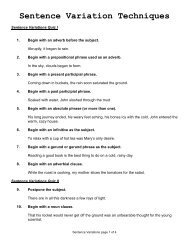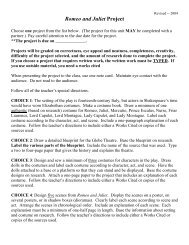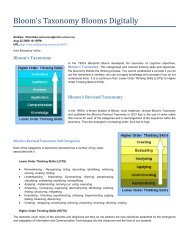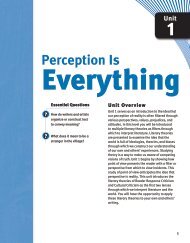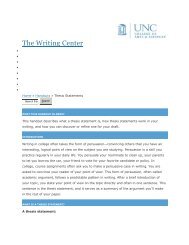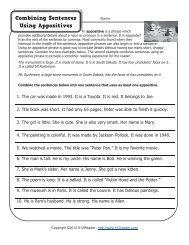Fallacies 101 - Southwest High School
Fallacies 101 - Southwest High School
Fallacies 101 - Southwest High School
You also want an ePaper? Increase the reach of your titles
YUMPU automatically turns print PDFs into web optimized ePapers that Google loves.
Activity<br />
2.13<br />
<strong>Fallacies</strong> <strong>101</strong><br />
SUGGESTED Learning Strategies: Brainstorming, Discussion Groups, Quickwrite<br />
Academic VocaBulary<br />
<strong>Fallacies</strong> are false or<br />
misleading arguments.<br />
<strong>Fallacies</strong> are ubiquitous in advertising, political discourse, and everyday<br />
conversations—and they will continue to be as long as they work as<br />
ways to persuade. However, by learning to recognize them when you<br />
see them, you can strip away their power. There are many different<br />
ways to categorize fallacies, and many different names for the various<br />
types. The following eleven fallacies (adapted from Brooke Noel Moore<br />
and Richard Parker’s Critical Thinking, 8 th ed, 2007), a rogue’s gallery of<br />
most frequent offenders, are divided into the different types of offense<br />
they represent. Learn these and you’ll be ready to see through many of<br />
the rhetorical scams that come your way each day.<br />
LOGICAL FALLACIES: ERRORS IN REASONING<br />
1. Hasty Generalization: The leap to a generalized conclusion based on<br />
only a few instances. For example, on a trip to Paris you meet several<br />
rude Parisians, leading you to conclude that French people are rude.<br />
2. Post Hoc: Literally meaning “after this,” it’s a causal fallacy in<br />
which a person assumes one thing caused another simply because<br />
it happened prior to the other. For instance, the high school soccer<br />
team loses an important game the day after they start wearing new<br />
uniforms. The coach blames the loss on the new uniforms.<br />
EMOTIVE FALLACIES: REPLACING LOGIC WITH<br />
EMOTIONAL MANIPULATION<br />
3. Ad Populum: Literally meaning “to the people”; refers to a variety<br />
of appeals that play on the association of a person or subject with<br />
values that are held by members of a target group (think of images<br />
of the flag in ads playing on patriotism), or the suggestion that<br />
“everybody knows” that something is true (as with bandwagon).<br />
4. “Argument” from Outrage: Aristotle said that if you understand what<br />
makes a man angry, you can use that anger to persuade him to accept<br />
a position without critically evaluating it. This fallacy is the backbone<br />
of talk radio and of political rhetoric on both extremes of the political<br />
spectrum. It often employs loaded language and labels. It also<br />
includes scapegoating—blaming a certain group of people, or even<br />
a single person.<br />
© 2011 College Board. All rights reserved.<br />
156 SpringBoard® English Textual Power Level 6
Activity 2.13<br />
continued<br />
5. Ad Misericordiam, or Appeal to Pity: If you’ve ever asked a teacher<br />
to give you a better grade or a second chance because things have<br />
been tough recently or because you worked SO hard, you’re guilty of<br />
this one! It refers to an attempt to use compassion or pity to replace<br />
a logical argument.<br />
6. Ad Baculum, or Scare Tactics: An appeal to fear in place of logic. If<br />
a candidate for office says “electing my opponent will open the door<br />
for new terrorist attacks,” it represents an attempt to scare people<br />
into rejecting the person, despite providing no evidence to justify<br />
the claim.<br />
© 2011 College Board. All rights reserved.<br />
RHETORICAL FALLACIES: SIDESTEPPING LOGIC<br />
WITH LANGUAGE<br />
7. Straw Man: Erecting a distorted or exaggerated representation of a<br />
position that is easily refuted. For example, Schroth says, “But, you<br />
say, if high schools drop football it will deprive colleges and the pros<br />
of their feeder system,” an argument that is, of course, a ridiculous<br />
attempt to justify high school football—and one that is thus easy to<br />
refute.<br />
8. Ad Hominem/Genetic Fallacy: Literally meaning “to the man,” ad<br />
hominem refers to attacks against a person rather than the ideas the<br />
person presents. This is a dominant feature in political campaigns,<br />
where sound-bite 30-second advertisements attack a candidate’s<br />
character, often with mere innuendo, instead of his/her policy<br />
positions. When this extends to criticizing or rejecting a general type<br />
of something simply because it belongs to or was generated by that<br />
type, you have the genetic fallacy. For example to say an idea comes<br />
from the “media elite” makes it sound as if it should be rejected—but<br />
who are the media elite<br />
9. Red Herring/Smokescreen: Answering the question by changing the<br />
subject. For example, when pulled over for speeding, a person might<br />
respond to the officer’s question, “Why were you speeding” by<br />
saying, “The school no longers offers driver’s education classes.”<br />
10. Slippery Slope: Half an appeal to fear and half a causal fallacy;<br />
people use a slippery slope when they suggest one action will lead<br />
to an inevitable and undesirable outcome. To say that passing gunshow<br />
background checks will lead to the repeal of the 2 nd Amendment<br />
represents a slippery slope argument.<br />
unit 2 • American Forums: The Marketplace of Ideas 157
Activity 2.13<br />
continued<br />
<strong>Fallacies</strong> <strong>101</strong><br />
11. Either/Or (or false dilemma): This is a conclusion that oversimplifies<br />
the argument by suggesting there are only two possible sides or<br />
choices. This fallacy is commonly used in debates of policy, where<br />
issues are always complex but which politicians reduce to simplistic<br />
either/or choices for rhetorical purposes.<br />
Quickwrite: In the space below or on your own paper, write a letter<br />
to the editor in which you use one of these fallacies to support your<br />
position. You might modify the letter you wrote in the previous<br />
activity or use the topic from today’s discussion.<br />
After exploring these fallacies in class and using one in a brief letter to<br />
the editor, discuss the following questions in a small group.<br />
• Why are fallacies so common in our political discourse Which ones<br />
are most common and why<br />
• Why are fallacies so powerful—and so dangerous<br />
• Why might you choose to use a fallacy—or rhetorical slanters—in a<br />
letter or speech<br />
• What would be the pros and cons of doing so<br />
• How does the use of fallacies affect the ethos of a writer or speaker<br />
• What is the relationship between considering your audience and<br />
deciding whether to use fallacious appeals or slanters<br />
© 2011 College Board. All rights reserved.<br />
158 SpringBoard® English Textual Power Level 6





